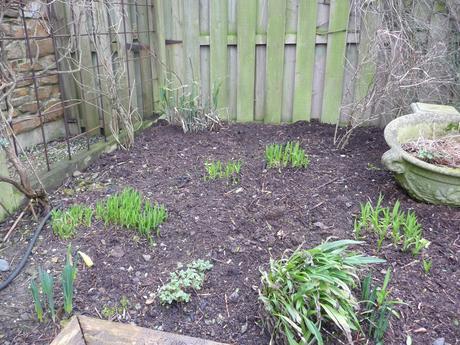 heap.
heap.Homemade compost is a great way of recycling, saving on trips to the local ‘green skip’, cutting down on rubbish that is removed to landfill and producing a free soil improver very easily. This ‘black gold’ is invaluable mulch for borders, improving the soil by adding organic matter to the surface in spring or autumn where it can be worked on by earthworms which will mix it with the top layer of your borders. Applying mulch also helps to seal in moisture which will mean less watering through the summer and it creates a thick blanket that will smother weed seedlings or at least make them much easier to pull up! Compost heaps do not need to be state of the art. They can literally be a heap in the corner of your garden that can be turned a couple of times a year, so that rotting material is mixed with the newer garden and kitchen waste and the composting process is speeded up. However, it is easier to have two compost bins made from timber so that partially rotted compost can be transferred from one to the other and the finished product spread on borders or bagged up and stored ready for use at a later date. Not everyone will have room for two bins, but there are plenty of products available from your local branch of Notcutts that will produce good compost and take up less room. Always site your compost area on a solid base - concrete or hard earth is fine - and layer up different garden waste to keep the air flowing through it. Too many grass clippings in one layer will result in a smelly, slimy mess that bacteria will be unable to break down. Mixed with coarser twigs or vegetable peelings, the whole thing will work properly. There are lots of items that can be composted but there are also a few that should never be. Cooked food will encourage vermin to your garden and litter tray waste from cats and dogs should never be added to your heaps. Clippings for grass that has been given a lawn ‘weed and feed’ treatment should also be avoided for the first three cuts after the treatment as the grass will contain traces of weed killer which could harm sensitive plants when the finished compost is used. All garden waste can be added and compost heaps will often be bulging after the spring and autumn garden tidy up! It is amazing how quickly your heaps will settle, allowing more material to be added. Cut material into short lengths and shred or chop woody material finely. Remember to layer up finer material with vegetable peelings or shredded paper and periodically sprinkle in some compost maker available from Notcutts. Wool, cardboard and fresh poultry manure can also be added along with saw dust produced from chopping logs, animal and human hair in fact, anything that is organic! The compost that is produced does not need to be ultra fine – it’s okay to have some lumpy bits that will still add to the soil improvement. If you have plenty of time, you may wish to shred or sieve the finished compost before using it. This way, any lumpy material can go back into the heaps to continue rotting down. Once you begin to produce your own compost it will become a way of life so don’t bin it, compost it and reap the rewards of one of the best (and cheapest!) soil conditioners available for your garden!
